
| 
|

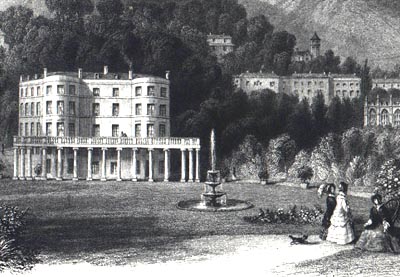
The Establishment Fountain
NGR 77641 45740
Site Number: C108
By Bruce Osborne and Cora Weaver (C) 2012
Area 1. Malvern Town Centre Springs and Wells
Malvern Hills, England
Description: the first large scale purpose-built hydropathic establishment in England with an impressive fountain in the grounds.
Circa 1843 Dr James Wilson, hydropathic practitioner, leased this plot of land and built an establishment where he could carry out his trade. The location was pre-determined by the availability of pure hill water, the most important ingredient for the success of his business. The landowner, Mr Mason, had already built a vast cistern, known as the Mason Tank, for the use of those wishing to acquire his land. The tank was situated directly across the road from the Establishment, on a plateau to the north of the Tudor Well Cottage (Tudor Well Cottage was located along the south side of Haywell path) and west of the present Baptist Church. The tank fed Fonthill, Chatsworth House, Tintern House and the Establishment and was suitable for drinking. The Establishment also relied on four other sources. It had its own well, located under the floor in the ladies' plunge bath, though the water was not suitable for drinking. On the few occasions when it was required the water was pumped straight into the Establishment and piped round the building for washing and cleaning purposes. The public main also served the building, but this water was expensive so not used unnecessarily. As a prerequisite to the construction of the Baptist Chapel in the early 1890s, the Trustees were obliged to provide the Establishment with a permanent supply, through a 1 inch pipe, of water from the Haywell Springs. To accommodate this a tank was constructed on the east side of the Chapel.
Dr Wilson died in 1867; the lease of the Establishment was taken over by Dr Rayner who died of cancer in 1891 and in 1892 Dr John Campbell Fergusson took a 7-year lease for 6,000 pounds. The business was so profitable that in 1899 he took a further 21-year lease at 500 pounds per annum. It was not until 1902 that he first noticed an `unknown' source of water. Like the other sources, apart from his private well, it was piped into a 14,000 gallon tank under the lawn by the main entrance and was used for all purposes. The overflow gravitated into a second tank, and this water was used for everything except drinking. This `unknown' source was a 2 inch pipe leading from the Tudor Baths Well.
From the 1840s until 1886, when the Tudor House was sold by the Gully family, the owners and occupants of the Tudor House were the beneficiaries of a well issuing 15,000 - 20,000 gallons per day. Whilst the town suffered year after year of water shortage, Gully had more than enough. It is significant that in 1864, when 14 medical men in the town signed a memorial stressing the need for a suitable public water supply Gully, then Chairman of the Board of Commissioners, elected not to sign 'as it was not couched in precisely the terms with which he agreed. But seeing this was a question which could not now be remedied, he was much afraid a definite answer could not be given to it at present'.[1] As a businessman it was to Gully's advantage that the other hydropathic doctors were kept short of water. As Chairman, he knew that if the vastness of his supply became known it could be commandeered by the Commissioners and used for public supply, as happened to Major Ward-Jackson in 1869. 1869 was the year that Dr Rayner, through necessity, was forced to take - illegally - water from the town supply to maintain his hydropathic establishment. Gully could not afford to be honest about his supply, nor allow himself to be drawn into prolonged discussions about likely sources to feed the public mains.
In the drought year of 1887, after the Tudor House had changed ownership, the Local Board was at last invited to pump the water from the well into the public mains. Unfortunately the pumping caused the water in the Mason Tank to sink to such a level that the owners and tenants of Fonthill, Tintern House and Chatsworth House - who relied solely on that source for their water - issued a writ against the Board in an attempt to have the supply reinstated. The pumping ceased. In 1898 the Malvern Urban District Council (successors of the Local Board) took a lease on the Tudor Well Cottage and gardens and once again pumped into the mains. The flow from the Mason Tank ceased but this time it appears that only Dr Fergusson noticed. Presumably he had plenty of water since he did not complain. In order to drain the cottage the Council laid new 3 inch pipes down the Haywell path, close to the open-jointed conduit which fed Dr Fergusson's 14,000 gallon tank. The town Surveyor knew that percolation from the drains, or an unexpected overflow through the manhole cover, would cause effluent to seep into the soil so kept a watchful eye on the new drain. In 1902 the Council's lease on the cottage and garden expired. For 4 years the cottage had been uninhabited to reduce the danger of contamination to the nearby fresh water conduits but after 1902 the cottage
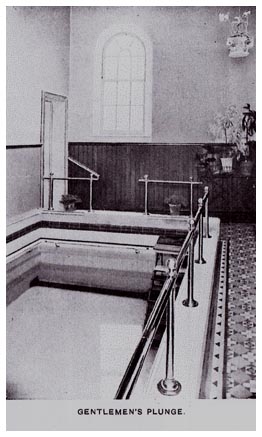 could once again become inhabited, bringing in rent to its owners, the Misses Brown and Mr Buckingham, who also owned the Tudor House.
could once again become inhabited, bringing in rent to its owners, the Misses Brown and Mr Buckingham, who also owned the Tudor House. On 30th April 1905 Dr Fergusson went to take his routine morning dip in the gents' plunge bath only to notice the unusual turbidity of the water. The recent heavy rainfall could have been the cause but whatever the reason, an establishment noted for the purity of its water, and to which doctors around the country recommended their patients, should be seen to have pure, translucent water. The following day the water was analysed and the tank emptied and refilled. The sample was not contaminated but the turbidity remained. On 4th May the doctor walked up the Haywell path to look for signs of a broken pipe but found nothing untoward. He also analysed the Baptist Chapel supply, which proved clean. On 5th May he re-analysed the tank water and found it to be contaminated. The contaminated source was the `unknown' source which he immediately shut off.
The `unknown' source was a 2 inch pipe leading to the Tudor Well. It was later suggested that in 1902, when the Council had emptied the Tudor Well tank at the end of their lease, Dr Fergusson had contrived to get access to the tank where he removed the plug and diverted the water to his own premises. This was never proven, though Dr Fergusson was very short of water in 1902. In that year, on an occasion when he knew the Chapel Minister to be in London, Fergusson excavated the 1 inch pipe leading to the Baptist Chapel source and laid some wider bore pipes in the trench. Before he had time to connect these to the supply the Minister returned and confronted him. Fergusson stressed that he was merely trying to capture water which was running to waste but the Minister was angry that neither he nor the Trustees had been consulted. Fergusson did not get his extra water.
Typhoid can lead to perforation of the bowels - and death. Lilian Davies, a maid-servant at the Establishment, died in Birmingham on 7th June 1905. Emily Plumeridge, a laundress, also died. One of Mrs Merton's sons from Eton died. Sixteen other people suffered long and painful symptoms. The sick, and the relatives of the deceased, sued the doctor and won 6,500 pounds, equivalent to over half a million pounds today. A blockage in the Council's 3 inch drain arguably caused the effluent to overflow from the manhole cover. The ordure percolated through the soil and into Dr Fergusson's ancient, open-jointed conduit. The recovered sick sued Dr Fergusson; they had come to Malvern for their health and he was on a warranty to provide uncontaminated water. Thousands of pounds were now due in compensation to those involved and yet the lowly Mr and Mrs Davies received just 15 pounds to cover the costs associated with the death of their daughter.
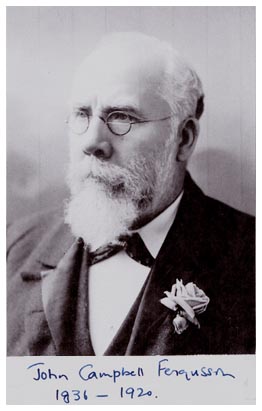
In July 1905, the Council recommended that the Sanitary Inspector be authorized to institute legal proceedings under the 1875 Public Health Act because of defective drainage causing a public nuisance at the Hydropathic Establishment. And so in July 1905 the Council began legal proceedings against Dr Fergusson. They argued that, in 1902, when they emptied the Tudor Well tank at the end of their lease, Dr Fergusson had managed to get access to the tank, remove the plug, and divert the water to his own premises. This was never proved, though Dr Fergusson was very short of water in 1902.
By November of the same year the Clerk of the Council reported being served with a writ by Dr Fergusson for restitution and acknowledgement of his water supply down Haywell Walk. Apparently the Oppenshaw v Fergusson case was coming for trial at the next Birmingham Assizes. By January 1907 it was confirmed that Fergusson was taking legal action against the Council.[2] The case was heard at the Birmingham Assises in January 1908. The courtroom battle lasted eleven days and commanded huge media attention. Dr Furgusson was awarded 7,600 pounds of Malvern taxpayers money 'for losses incurred by him by reason of the drinking water at the Malvern Hydropathic Establishment having been polluted by sewage, which he alleged had negligently escaped from sewers under the defendant's control'.[3]
The Council members were stunned and immediately appealed. They argued that the judge had misled the jury; that there was not sufficient evidence to prove their negligence, and that the award had been too much. In May 1908 they won their appeal and costs were awarded totalling 5856 19s.6d.[4] Dr Fergusson appealed to the House of Lords. He lost again. There were hearty slaps on the back and congratulations all round in the Council chamber.
In June Dr Fergusson's 26 year old son John Newbery Fraser Fergusson, also a doctor, took over the running of the Establishment. By November 1908 the compensation has still not be paid and the Clerk of the Council was instructed to move Dr Fergusson's bankruptcy.[5] In July 1909 Dr Fergusson was adjudicated bankrupt. His net liabilities were 21,288 pounds 8 shillings and 5 pence and his assetts were 16 pounds 10 shillings and a watch and chain worth 15 pounds that was at the repairers. The adverse publicity badly affected the business. In April 1913 young Fergusson was also declared bankrupt due to 'Want of capital',and loss upon the business which has never completely recovered from the effect of the typhoid fever which broke out in 1905, and was the primary cause of my father's failure in the same business".[6] It was suggested that his father had lost 20,000 pounds as a result of the typhoid outbreak.
The Establishment closed but reopened as the County Hydro. This in turn was sold in 1929 and Lady Honywood auctioned the entire contents before embarking on a 60,000 pound scheme to turn the County Hydro into the County Hotel, thus terminating any vestiges of hydropathy in Great Malvern. The ornamental fountain in the gardens of the Establishment vanished with it.
At the beginning of 1948 the County Hotel was taken over by Western and Midlands Hotels Ltd. Shortly afterwards its name changed to Park View when it became residential apartments for the apprentices training at the government's Telecommunications Research Establishment based in Malvern. In 1983 the building was turned into the privately owned Park View Apartments, the name and function it still maintains. The remains of Dr Wilson's baths survive beneath the floors.
Illustrations:
1. The Establishment from Stanley's Worcs and Malvern Guide, 1852, p.250 which shows the rear of the building with fountain. (courtesy of Chris and Roland Bannister)
2. The County Hotel or Establishment from the front.
3. The infamous Gentleman's Plunge Bath. (courtesy Fergusson family)
Footnotes:
[1] Malvern Gazette, 5 November 1864.
[2] Minutes of Malvern Urban District Council 26 July 1905, 7 November 1905, 1 Jan 1907.
[3] Malvern Gazette, 1 May 1908 [4] Minutes of Malvern Urban District Council 5 May 1908.
[5] Minutes of Malvern Urban District Council November 1908.
[6] Malvern Gazette 11 April 1913.
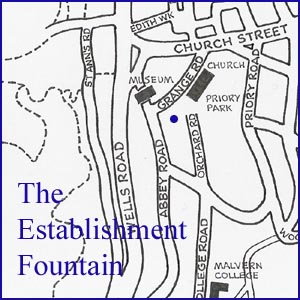
The map alongside is a small section of our more comprehensive map of the area. For the complete map together with a description and history of this site see "Celebrated Springs of the Malvern Hills" (2012).
Website: Click Here
SUPPLEMENTARY INFORMATION

Celebrated Springs of
THE MALVERN HILLS
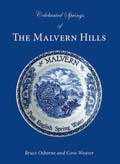 A definitive work that is the culmination of 20 years researching the springs and wells of the Malvern Hills, published by Phillimore. This is the ideal explorers guide enabling the reader to discover the location and often the astounding and long forgotten history of over 130 celebrated springs and wells sites around the Malvern Hills. The book is hard back with dust cover, large quarto size with lavish illustrations and extended text. Celebrated Springs contains about 200 illustrations and well researched text over a similar number of pages, together with seven area maps to guide the explorer to the locations around the Malvern Hills. It also includes details on the long history of bottling water in the Malvern Hills.
A definitive work that is the culmination of 20 years researching the springs and wells of the Malvern Hills, published by Phillimore. This is the ideal explorers guide enabling the reader to discover the location and often the astounding and long forgotten history of over 130 celebrated springs and wells sites around the Malvern Hills. The book is hard back with dust cover, large quarto size with lavish illustrations and extended text. Celebrated Springs contains about 200 illustrations and well researched text over a similar number of pages, together with seven area maps to guide the explorer to the locations around the Malvern Hills. It also includes details on the long history of bottling water in the Malvern Hills.
Written by Bruce Osborne and Cora Weaver, this book is available on-line for £15.00 (delivered UK) - click Malvern Bookshop on the green panel top left. Alternatively send a cheque payable to Cora Weaver with your name and address to 4 Hall Green, Malvern, Worcs. WR14 3QX.
1) TOPOGRAPHICAL LOCATION:
Malvern Hills - arguably Britain's original National Park
2) LANDSCAPE:
Park or Garden3) INFORMATION CATEGORY:
Springs and Wells General Interest4) MALVERN SPRING OR WELL SITE DETAILS:
1 SPLASH - Lost - Nothing Much To See
5) GENERAL VISITOR INFORMATION:
Access On FootOn Private Property


